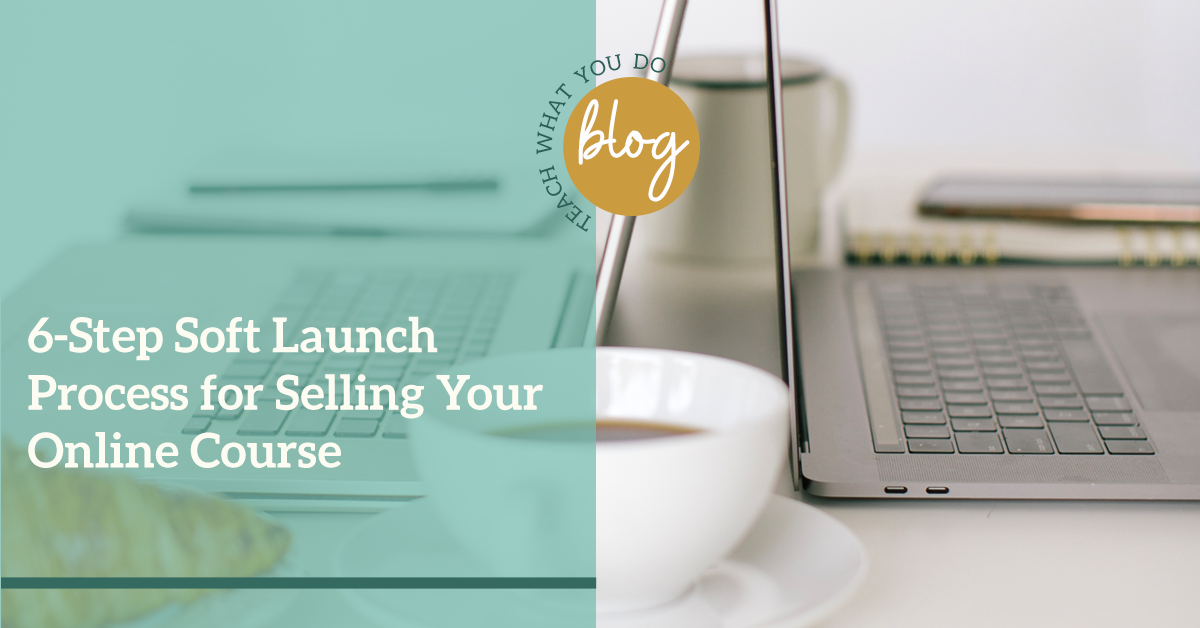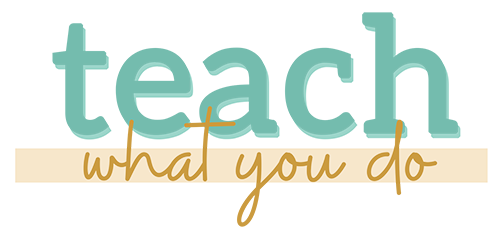
When you get started with online teaching by offering a “minimum viable product” (MVP) or beta version of your course (which you will refine based on student feedback), you’re overlapping the work of development and selling—even blurring the lines between the two.
By that I mean that your first sales are made with a limited launch of a product you plan to revise.
The sales of these early products can be done with a soft launch. Here's how the soft launch goes in a nutshell:
- In the pre-launch and research days, you’ll be building a small group of prospects and engaging deeply with them. You’ll do this both to determine what to offer and to build interest among the best prospects.
- You’ll then offer your course to these people incentives like a short quick road to early results or a lower price or access to future updates in order to test course viability and performance. The goal is to get first students in with benefits to them as early adopters and so that you can test your course viability and performance.
- Once you’ve enrolled and taught a group of students, you’ll get feedback from them to enable you to understand your next steps—how and how much you need to modify this offer for future launches.
Here's a 6-step process for running your own soft launch.
STEP 1 Develop first audience connections as you research and develop your “nimble” offer {PRE-LAUNCH}
Step 1 has to do with the pre-launch phase—and this starts with growing your first audience connections as you research and develop your “nimble” offer.
This work might start casually on one or two social platforms (Facebook, YouTube, Instagram, Linked In, Blog posts). You’ll find your best social home as you execute on early research and engagement. If you’re going to teach on a topic, it’s important that you be passionate enough about it, interested enough in it, that you are ready and willing to become an known participant in at least three communities.
As you’re spending time in communities, you’ll need to be consistently answering questions, sharing free tips that educate and entertain and building up your authority. You need to be seen and become familiar and trusted with a small and engaged group of people who could become your fans.
Create a “lead magnet” or a list building “freebie” that you offer up to move those people who know you on social platforms onto your email list.
STEP 2 Be prepared for “launch leaking” and the “early bird” list
Step #2 is getting prepared for “Launch Leaking” and the “Early Bird” List. You’re about to move onto engaging even more deeply with your people. They’ll be paying close attention and it gives you a chance to hint at details about what’s coming. Launch specialist Anne Samoilov calls this “launch leaking.”
A COURSE NAME. Be ready to tell people that a first beta or MVP version of your special course is coming–and that you’ll let them know there will be a special opportunity for them to participate.
AN OPT-IN LANDING PAGE FOR EARLY BIRD LIST. And you’ll invite them to get on the early bird list—so get that list set up!
Even if you already have people on a general mailing list, set up a segment of people who are asking for notification of when your class starts. You’ll need to create a web page – a landing page – just for people to request early bird notice of your offer.
STEP 3 Create and deliver “red-carpet” content
Develop three or four pieces of content that you can deliver in the weeks leading up to your offer. This content should be as inviting and simple to navigate as a red carpet rolled out in front of the door to an event everyone wants to get in on.
Your course is at the door. Your work is to get your prospects happily walking the carpet—and as they reach the front door, buying a ticket to get in.
THE CONTENT. The content of these pieces should be simple and useful, getting people thinking about and even taking first steps toward the work of your course. You can teach in come pieces and speak to mindset in others. Especially helpful is if you can address one or two “limiting beliefs” that have kept your prospects from moving forward before now.
THE FORMAT. Develop this content in short lessons for delivery live—in a Facebook and/or Instagram Livestream. When you’re on in this format you should aim to be “personal and prepared.” Delivering live adds the personal touch. Thinking through the content ahead of time and knowing exactly which points you’re hitting adds the prepared touch. You want to be building your authority at the same time you’re helping prospects feel they really can do this—especially with you as their guide.
REPURPOSE. Consider how you can get this content used and shared in multiple spots. For example:
- Start with a written blog post.
- Deliver that blog post content live on Facebook or Instagram.
- Make a short video excerpt to share on IGTV (Instagram TV).
- Create social media posts for Facebook or Instagram or Twitter or Linked based on the content and pointing people to the full version.
CALL TO ACTION. At the end of each piece of content, tell people to go to your “early-bird” landing page to sign up for first notice of your upcoming course availability–as well as special pricing. Use a simple URL to the webpage. (You can use a plugin like Pretty Link to do this).
NOTE: You could skip this step, and make an initial offer via email if you know that you’ve got a small but viable group you believe will bite – and if that group size and makeup works for you. You might also modify and shorten or lengthen. With this process, though, you’re able to warm up an audience without spending ads dollars. Even if they don’t buy this round, some of them probably will in future sessions.
STEP 4 Set up content delivery process and sales mechanism
You can use an ecommerce tool that delivers course files to keep this simple. While you'll want a full-blown classroom and shopping cart later on, right now using a tool like SendOwl, eJunkie, Sellz, or Gumroad. Before you move onto the next step of your soft launch, make sure that your ecommerce tool is set up and working.
MINI COURSE SETUP. If you’re creating a mini-course and have it all ready now, you can even set up lessons to be delivered—that means getting the files uploaded and having emails ready to go out for the delivery.
BETA COURSE SETUP. If you’re pre selling a beta version of your course, set things up as much as you can. That means that after purchase students will immediately get a welcome email that tells them what to expect – and then as your course rolls out, you’ll send more emails and share links to course content.
SALES PAGE. You’ll need to make a sales page that presents your offer and provides that ecommerce button to buy. Keep the sales page simple for now, and rely on your live teaching and your offer emails to describe the offer more completely.
STEP 5 Make the offer
FIRST, make the offer to those on your early-bird list. If you can, give them 48 hours to get an even better price than you’ll publicly announce.
NEXT. In your last live “red-carpet” content session and in an email, make the offer for your class and provide a link for the sales page.
The “offer” includes:
- A description of what people will be able to do with the course.
- How getting this transformation is a good thing for your prospects.
- What they’ll get specifically in terms of lessons and support and how and when it will be delivered.
- How much this offer costs
- What the expiring urgency is in the offer. In other words, why buying now saves money or earns bonuses – and how long this offer will be available for.
STEP 6 Count down the expiring offer
Your offer should be available for 5 to 10 days. Send out several emails during that time—to your complete mailing list.
Here’s a suggested sequence:
Day 1. Present the full offer. The first email will present the offer as we just talked about it, including the class transformation and benefits, features, pricing and expiring bonuses, pricing, and/or availability.
Over the next 3 to 6 days, send out emails that cover any or all of:
- Case studies of how people experiencing this transformation benefitted
- Stories that will motivate people to enroll. They might illustrate why the transformation matters, how people have achieved this transformation, even stories from well-known media that can connect meaningfully.
- Answers to frequently asked questions (or FAQs) especially as they connect to student objections.
- Describe limiting beliefs that probably exist for your students and explain why, with your course, they can be let go.
- Reminders of expiring aspects of the offer.
- Testimonials and social proof.
- A “this-is-right-for-you-if” checklist.
- On the final day, send two emails that remind people that the doors are closing and of what they’ll be missing if they forgo this opportunity.
Once time is up for the offer, be sure to redirect links going to the sales page. The best option is to redirect that sales page to the opt-in for the waiting list the next time this course is offered.
Now it's time to get your soft launch rolling. . .
…unless you still need to figure out what your MVP is. If so, check out this article and know that this is also covered more deeply in our signature class Quick Start module: How to Make First Online Teaching Sales with a Beta or MVP Offer
Otherwise, click here to get a free pdf guide to extended details on executing a soft launch, examples of beta and MVP topics, and options on delivery of these early classes in your portfolio.
